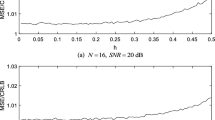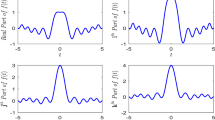Abstract
In this paper, we present several new properties of the recently introduced interleaved DFT modulated filter bank and an efficient algorithm for designing the filter bank. The periodicity and symmetry properties of the overall transfer function and aliasing transfer functions are stated. Then the design of the filter bank is formulated into a constrained optimization problem that jointly minimizes the overall distortion and aliasing distortion subject to fixed bounds on the stopband energy, transition-band energy, and passband flatness of the prototype filters. The constrained optimization problem is solved by the 2block Gauss-Seidel method, which alternatively optimizes the analysis PF pair and the synthesis PF pair. Since the overall distortion and aliasing distortion are jointly minimized, the proposed algorithm can lead to filter banks with small reconstruction error, even when the filter banks behave with a low redundancy ratio and short PFs. The convergence of the proposed algorithm is proved. Numerical examples and comparisons with the existing method are included to demonstrate the performance of the proposed algorithm.





Similar content being viewed by others
References
H.H. Dam, S. Nordholm, Iterative method for the design of DFT filter bank. IEEE Trans. Circuits Syst. II, Express Briefs 51(11), 581–586 (2004)
J.M. De Haan et al., Filter bank design for subband adaptive microphone arrays. IEEE Trans. Speech Audio Process. 11(1), 14–23 (2003)
B. Dumitrescu, R. Bregović, T. Saramäki, Simplified design of low-delay oversampled NPR GDFT filterbanks. EURASIP J. Appl. Signal Process. 2006, 1–11 (2006)
M. Grant, S. Boyd, Y. Ye CVX, Matlab software for disciplined convex programming (2008). Online accessible: http://stanford.edu/~boyd/cvx
L. Grippo, M. Sciandrone, On the convergence of the block nonlinear Gauss–Seidel method under convex constraints. Oper. Res. Lett. 26(3), 127–136 (2000)
P.N. Heller, T. Karp, T.Q. Nguyen, A general formulation of modulated filter banks. IEEE Trans. Signal Process. 47(4), 986–1002 (1999)
J.H. McClellan, T.W. Parks, A personal history of the Parks-McClellan algorithm. IEEE Signal Process. Mag. 22(2), 82–86 (2005)
T.Q. Nguyen, Digital filter bank design quadratic-constrained formulation. IEEE Trans. Signal Process. 43(9), 2103–2108 (1995)
R.L.D. Queiroz et al., The GenLOT: generalized linear phase lapped orthogonal transform. IEEE Trans. Signal Process. 44(3), 497–507 (1996)
E. Schulz, M. Weckerle, E. Costa, An efficient digital implementation of multicarrier CDMA system based on generalized DFT filter banks. IEEE J. Sel. Areas Commun. 24(6), 1189–1198 (2006)
P.L. Shui, X.L. Wang, 2M-band interleaved DFT modulated filter banks with perfect reconstruction. Int. J. Wavelets Multiresolut. Inf. Process. 6(4), 499–520 (2008). 2008
P.L. Shui, Image denoising using 2-D separable oversampled DFT modulated filter banks. IET Image Process. 3(3), 163–173 (2009)
P.L. Shui, J.Z. Jiang, X.L. Wang, Design of oversampled double-prototype DFT modulated filter banks via bi-iterative second-order cone program. Signal Process. 90(5), 1597–1608 (2010)
P. Siohan, C. Roche, Cosine-modulated filterbanks based on extended Gaussian functions. IEEE Trans. Signal Process. 48(11), 3052–3061 (2000)
J.F. Sturm, Using SeDuMi 1.02, a Matlab toolbox for optimization over symmetric cones. Optim. Methods Softw. 11–12, 625–653 (1998)
P.P. Vaidyanathan, Multirate Systems and Filter Banks (Prentice-Hall, Englewood Cliffs, 1993)
X.L. Wang, P.L. Shui, Critically sampled and oversampled complex filter banks via interleaved DFT modulation. Signal Process. 88(12), 2878–2889 (2008)
M.R. Wilbur, T.N. Davidson, J.P. Reilly, Efficient design of oversampled NPR GDFT filterbanks. IEEE Trans. Signal Process. 52(7), 1947–1963 (2004)
K.F.C. Yiu, N. Grbic, Multicriteria design of oversampled uniform DFT filter banks. IEEE Signal Process. Lett. 11(6), 541–544 (2004)
X.P. Zhang, M.D. Desai, Y.N. Peng, Orthogonal complex filter banks and wavelets: some properties and design. IEEE Trans. Signal Process. 47(4), 1039–1048 (1999)
Z.J. Zhang, Efficient design of cosine modulated filter banks based on gradient information. IEEE Signal Process. Lett. 14(12), 940–943 (2007)
Z.J. Zhang, P.L. Shui, T. Su, Efficient design of high complexity cosine modulated filter banks using 2Mth band conditions. IEEE Trans. Signal Process. 56(11), 5414–5426 (2008)
Acknowledgements
This work was supported by the National Natural Science Foundation of China under grant 61261032, the Guangxi Natural Science Foundation under grant 2013GXNSFBA019264, and the Project of Guangxi Experiment Center of Information Science under grant 20130305.
Author information
Authors and Affiliations
Corresponding author
Appendix: Efficient Calculation of Matrices Φ a,y ,a=0,…,[K/2] and Vectors r y for y=p,q
Appendix: Efficient Calculation of Matrices Φ a,y ,a=0,…,[K/2] and Vectors r y for y=p,q
With (6), (12a), and (12b), matrix Φ a,p can be written as
Denote \(\boldsymbol{\Phi}_{a,\mathbf{p}}^{k_{0},k_{1}} = \int_{0}^{4\pi /M} \boldsymbol{\Theta}_{k_{0},a}(\omega )\mathbf{p}_{0}\mathbf{p}_{0}^{T}\boldsymbol{\Theta}_{k_{1},a}^{\dagger} (\omega )\,d\omega,k_{0},k_{1} = 0,1\), and its (s,t)th element is evaluated by
In (A.2), the integral is independent of the PFs and is only required to be calculated once. In the integral, element \(\boldsymbol{\Theta}_{k_{0},a}(\omega )[s,k]\) can be calculated by invoking the property of the DFT:
Analogously, element \(\boldsymbol{\Theta}_{k_{1},a}^{ *} (\omega )[l,t]\) is equivalent to
Consequently, the integral in (A.2) is equal to
From (A.2) and (A.5), only a few multiplications are required in the computation of \(\boldsymbol{\Phi}_{a,\mathbf{p}}^{k_{0},k_{1}}[s,t]\), resulting in an efficient calculation of matrix Φ a,p . The calculation of matrices Φ a,q can be performed similarly.
Also, in terms of the symmetry of matrices Θ 0,0(ω) and Θ 1,0(ω), vector r p is
Denote \(\mathbf{r}_{k,\mathbf{p}} = \int_{0}^{4\pi /M} e^{jD\omega} \boldsymbol{\Theta}_{k,0}(\omega )\mathbf{p}_{k}\,d\omega,k = 0,1\), whose lth element is calculated by
From [17], the delay D is a multiple of M, i.e., D=Mn d . Thus, the integral in (A.7) is evaluated by
Therefore, r k,p can be calculated quickly, resulting in an efficient evaluation of r p . Vector r q can be analogously computed.
Rights and permissions
About this article
Cite this article
Jiang, J., Zhou, F. & Ouyang, S. Design of Oversampled Interleaved DFT Modulated Filter Bank Using 2Block Gauss-Seidel Method. Circuits Syst Signal Process 33, 549–564 (2014). https://doi.org/10.1007/s00034-013-9655-7
Received:
Revised:
Published:
Issue Date:
DOI: https://doi.org/10.1007/s00034-013-9655-7




